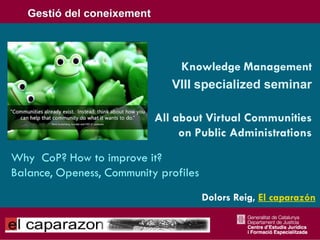
Communities, Orientation
- 1. Knowledge Management VIII specialized seminar All about Virtual Communities on Public Administrations Why CoP? How to improve it? Balance, Openess, Community profiles Dolors Reig, El caparazón
- 2. Different kind of communities, differents goals: Communities already exists © Will Lion CC BY- NC - ND
- 3. Communication - Conversation A community can born wherever it occurs a conversatoin EASY, ABUNDANT It was never so easy to create groups (community concept is not scarce yet) Clay Shirky
- 4. Virtual CoPs Orientation, Goals Individual Organizational 1. Social Learning (P2P), 1. Knowledge management -Learning to know – to be (Seeley Brown) -Learning organizations (Senge), Benchmarking (Expertesa) -Corporate expertise -Digital Competencies, Digital Wisdom. -Knowledge products -Project, product development across different areas. -Collaboration 2. Relationships –Positive work environment 2. Relationships – Atention - Context Providing 3. Digital Reputation: Label construction - Work satisfaction -Organizational Atention, Relevance, Visibility -Digital identity construction (e-portfolios) - Antenna -Social enterprise Culture (CSR) 3. Professional Reputation -Expertise Projection (Institutional e-portfolio) -Relevance, +Atention, Visibility, voice -Antenna -Self-Realization
- 5. New scarcity: Atention, relevance -Needs balance KNOWLEDGE INTERACTION VISIBILIY – REPUTATION - ANTENA Individual needs Institutional needs (group aglutinadors del grup)
- 7. Learning / Knowledge Comunitats orientades a contingut, projectes concrets: Wikipedia Comunitats d´experts, orientades a solució de problemes. PLE FÒRUMS WIKIS
- 8. CoPs as a central element in Open Social Learning Cop Cop Cop Communities of Practice: a Social Discipline of Learning (Wenger) Modificat de
- 9. Community and learning PERSONALIZED Until now, the filter was professional post-production. In the era of mass amateurism, things are first published and then filtered through folksonomías, links, etc... Collaborative knowledge construction. The best content, evaluated in a P2P way or with new criteria in the network, become part of the institution (increasing knowledge of discipline)
- 10. Relationship Open ended Conversation communities: Social and technichal dialog. Relationship oriented Communities FORUMS, CHATS, MICROBLOGGING
- 11. Visibility, Reputation Individual Participation oriented Communities Corporative Blogs Social, Interest networks Blog Planets Mashups – Institutional e-portfolios BLOGS (microsoft)
- 12. Human motivation pyramid (Maslow) Interest networks come form self- 3. Visibility, Relevance actualization drive Personal Learning Networks 1. Knowledge Social networks come from affection 2. Relationship, Atention
- 13. 7 principles, 5 towards openness 1. Design for development 2. Open dialogue between internal and external perspectives 3. Invite different levels of partitipation 4. Development of public and private spaces 5. Focus on values 6. Merge familiarity and stimulus 7. Create a pace for community participation 7 principles from Wenger, E., McDermott, R., & Snyder, W. M. (2002). Cultivating Communities of Practice. Boston: Harvard Business School Press.
- 15. Openness as a success key street exit © [phil H] CC BY – NC ND
- 16. Natural evolution as networks: http://www.orgnet.com/BuildingNetworks.pdf
- 17. Boundaries, areas Privacity, regulations World WIDE Web
- 18. Network amplifies effects Individual Organizational 1. 2.0 Learning 1. Fluid Knowledge 2. Relationships , 2. Relationships, conversation conversation 3. Digital reputation 3. Digital Reputation
- 20. Thanks!
